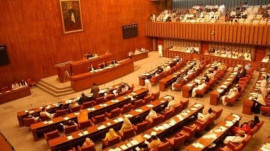
That happens on a desolated piece of land adjacent to Sibi Bypass, located at a drive of a few minutes from the sleepy Sibi town. Here at the 220 kilovolt (KV) grid station, electricity meshes up with that coming from Guddu power plant, which is situated 225 kilometres away in Kashmore.

As a matter of fact, electricity produced by all the power plants scattered around the country mix up through a network of 13,340 kms long transmission lines – a mobile phone is charged in Karachi probably because a Wapda engineer is up at midnight to ensure turbines keep running at Tarbela Dam.
But the collapse of power grid, which plunged almost the entire country into darkness in wee hours of Sunday, has left top industry experts guessing if everything is alright with the way the system works.
“This is the fourth time something like this has happened in 45 days,” said Tahir Basharat Cheema, the former managing director of Pakistan Electric Power Company (Pepco), which oversees all the thermal power plants.
“This is something unprecedented and it shouldn’t have happened in quick successions.”
As per the official version, after the 220kv transmission line in Sibi was blown up and supply from 700MW Uch power station was cut off, the Guddu plant could not keep up with additional load and tripped.
That caused a domino effect, forcing power plants everywhere to shut down one after another. Power demand in Pakistan is hovering around 14,000MW against a supply of 10,000MW, creating a large shortfall that is bound to put pressure on the system.
But Cheema says this reasoning doesn’t hold water. “We faced a much bigger crisis when power production dropped by half to just 5,200MW after the assassination of Benazir Bhutto on December 27, 2007. But even then the entire national gird didn’t collapse.”
Khalid Mansoor, Hub Power’s CEO, was also up the entire night as his company’s 1200MW plant had gone down too.
“Plants operate at a frequency of 50 hertz. They are designed to handle variation of 3% to 4% but anything more than that causes them to trip,” he said.
In case miscreants blow up a transmission tower or create a spark in the power line, a low frequency signal travels back to the plant, which in turn tries to keep up with demand and ultimately fails, he explained.
Every power plant is designed to meet certain requirements of the national grid depending on its location and how far the energy needs to be transported.
Hubco produces electricity at only 23kv. Then it increases the voltage to 500kv, so it can travel over a relatively longer distance.
Mansoor said investment was badly needed in the transmission and distribution system. “There are a lot of things that need to be done but this is what we need to do immediately.”
Industry people say even if few power plants trip, the effect should have been contained to a specific area.
Najamul Hasan Farooqi, an energy consultant, said that one probable cause could be change in ‘safety margins’ for a tripping.
“Power plants are designed to afford frequency variation within the range of 49.25 hertz and 50.75 hertz. But officials have actually changed the limits to 49 hertz and 50 hertz. That’s asking for too much.”
Electricity supply began to come back online in Karachi and other parts of the country by 7am. It took a few more hours for the entire system to come back online.
Experts and industry officials are unanimous that government needs to hire professionals as head of key institutions like Pepco, the NTDC and Wapda to stop blackouts from recurring.
Published in The Express Tribune, January 26th, 2015.


















COMMENTS
Comments are moderated and generally will be posted if they are on-topic and not abusive.
For more information, please see our Comments FAQ